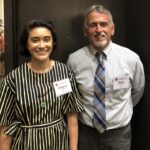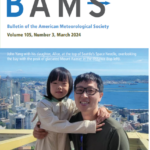From the polar ice caps to the deserts of China and Chile, from the skies over California to the Atlantic Ocean near Northeast Brazil, ESSIC scientists are busy examining the Earth System through the various lenses of their particular specialties. Cutting across the traditional disciplinary boundaries of meteorology, oceanography, hydrology, geology, geography and many others, ESSIC seeks to better understand how the land, the oceans and the atmosphere interact with, and influence, one another, as well as analyze the increasing influence of the human-print. These interrelationships profoundly affect the current and future health and welfare of our planet and all its inhabitants. Science progresses by posing informed questions and seeking the answers to them.
At ESSIC, some of the questions our researchers are exploring are: How do the ocean, atmosphere, and land surfaces interact to induce changes in climate? How can we get better at predicting long-term climate events like droughts and floods? What effects are human activities like CO2 emissions and deforestation really having on our planet? How is carbon partitioned between land and ocean reservoirs? What are likely scenarios of water, energy, food across the world, and the impacts of changes in climate, land use and population on these scenarios?
Determining the answers to these big questions, however, often involves examining small, and some might say, esoteric, pieces of the puzzle. And this makes ESSIC a very unique place in the evolving landscape of Earth System Science.
I take on the role of Interim Director of ESSIC in very interesting times. We are now to the point where ESSIC is the largest research unit at the University of Maryland, with about 160 full-time scientists. So, a major focus of mine moving forward is managing growth and solidifying ESSIC’s foundation for the future.
I truly believe that ESSIC is poised for greater growth, certainly in numbers, but more importantly in the nature of the science we can tackle, and on the impact that this science can have on multiple sectors of society. Being immersed in the greater Washington DC metropolitan area, close to both the headquarters and major research facilities of the country’s funding agencies with a stake in earth science, environmental and sustainability issues (not only NASA and NOAA, but also DoE, EPA, USDA, USGS and others. There are also significant international development opportunities with USAID, the World Bank and other similar institutions that are based in Washington DC with which ESSIC has started to interact recently. This is a competitive advantage that makes ESSIC unique among its peer institutions. The ability to attract scientific talent throughout the range of younger researchers to mid-career and senior scientists, as ESSIC has been able to do over the recent years, is a differentiator that can be built on to boost the growth of ESSIC’s research enterprise.
Given the breadth and depth of ESSIC’s academic and research faculty, the opportunity exists to develop major new interdisciplinary and transdisciplinary initiatives. Recently, we have started to strengthen our working relationship with the Joint Global Change Research Institute (JGCRI) of DoE’s Pacific Northwest National Laboratory; collaboration between ESSIC and JGCRI is now headed in a very positive direction with funding from international organizations such as the World Bank and USAID.
And while collaboration with our federal partners has been strong, one potential area for synergy that remains to be realized is with the private sector. Given our location at the university’s research park, M Square, this could and should be an environment where the interests of federal laboratories of the region, the university, and the private sector come together for mutual benefit; this is a challenge that lies ahead. Because Earth System Science has matured as a field of knowledge, and research conducted at ESSIC (for the most part) under NASA and NOAA sponsorship is increasingly yielding products that can be transitioned into operational forecasting, there exist significant opportunities in research-to-operations (R2O). This is a major area of interest currently for several offices in NOAA, for instance. This opens possibilities for generating start-up companies or incubating small businesses focused on providing operational products in Earth System Science related areas (e.g., weather and climate, water resources, agricultural, ecosystem management) to broaden the range of services that are made available to an expanding market of clients for such services. This focus area also offers potential synergies for increased interactions between federal agencies, university researchers and the private sector concentrated in M Square. Specific applications that can be envisioned in the near future relate to drought, flood, food production, power generation and general infrastructure services. Such companies can be housed at M Square, and ESSIC can serve in a catalytic role for this transformation.
Although ESSIC is a research center, with respect to the educational mission of the university, we continue to work within and support our partner academic departments of Atmospheric and Oceanic Science, Geology, and Geographical Sciences. ESSIC faculty, both academic and some research faculty, advise graduate students, provide undergraduate research opportunities, teach existing classes, and initiate new courses. Expanding our role in teaching and training students at UMD will continue to be an activity we place focus on. We work towards a tighter integration of ESSIC with education (particularly undergraduate, but graduate as well) at UMD. Although specific efforts and actions have been made in recent years (double the academic faculty, increased involvement in teaching, financial contributions to student assistantships), there is still room to further engage the academic community in ESSIC activities, particularly students. For instance, recent interactions with NOAA have identified opportunities for students (internships and research project assignments); demand is growing for the student summer program that was started at CICS. NASA also sponsors a student summer program with already large demand. Earth System Science is an emerging field that is bound to bring into its fold complementary expertise from the social sciences (e.g., public policy and security issues), engineering (e.g., R2O), life sciences (e.g., public health) and perhaps others.
I look forward to updating this message and thank you for visiting our website. I encourage you to follow us through social media: follow us on Twitter (@ESSICUMD), Facebook (ESSIC-UMD), as well as our YouTube channel.
Professor and Director of ESSIC
Ellen Williams






